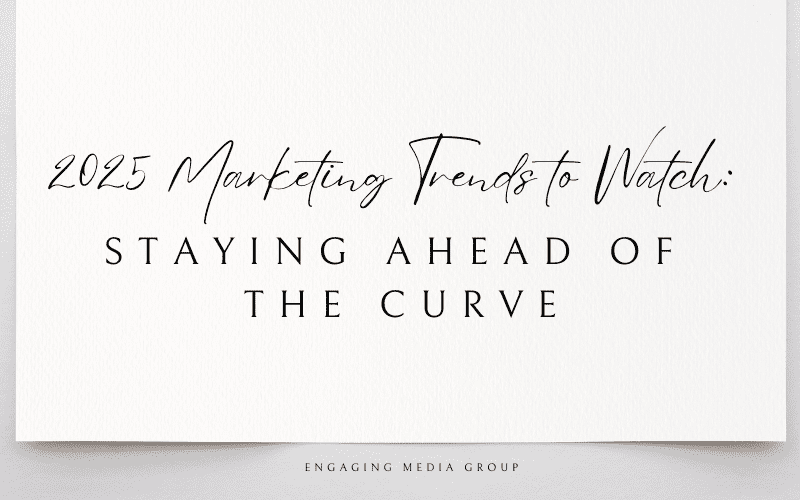Introduction
As we step into 2025, the marketing landscape continues to evolve at an unprecedented pace. From advancements in technology to shifts in consumer behavior, staying ahead of these changes is critical for businesses to remain competitive. In this blog post, we’ll explore the key marketing trends set to shape the year and provide actionable insights to help your business adapt and thrive.
Key Trends Shaping Marketing in 2025
1. Hyper-Personalization Through AI
Consumers now expect tailored experiences, and AI is making hyper-personalization more achievable than ever. Businesses can leverage AI to analyze customer data, predict behavior, and deliver highly customized content, offers, and recommendations.
How to Adapt: Use AI-driven tools to segment your audience and create personalized campaigns. Platforms like ChatGPT and machine learning algorithms can help craft unique email copy or product suggestions.
2. Voice and Visual Search Optimization
With the rise of smart speakers and visual recognition tools, voice and visual searches are becoming essential in the consumer journey. People increasingly rely on voice commands and image searches to find products and services.
How to Adapt: Optimize your website for voice and visual searches. Use conversational keywords and ensure your images have descriptive alt text to rank better in search engine results.
3. The Dominance of Short-Form Video Content
Platforms like TikTok, Instagram Reels, and YouTube Shorts continue to capture audiences with engaging short-form videos. This trend is not just for entertainment but also for educational and promotional content.
How to Adapt: Invest in creating short, impactful videos that showcase your products or services, provide quick tips, or tell compelling stories. Keep the content visually appealing and aligned with your brand’s voice.
4. Sustainability and Ethical Marketing
Consumers are increasingly drawn to brands that prioritize sustainability and social responsibility. Transparent marketing that highlights eco-friendly practices and ethical values will resonate with a conscious audience.
How to Adapt: Share your sustainability initiatives and commitment to ethical practices through authentic storytelling. Highlight how your business contributes to a better future.
5. Interactive and Immersive Content
From augmented reality (AR) shopping experiences to interactive quizzes and polls, engaging content is becoming a must-have for brands to captivate audiences.
How to Adapt: Incorporate interactive elements into your marketing campaigns. For instance, use AR to allow customers to try on products virtually or create quizzes to recommend products.
6. Increased Focus on First-Party Data
With evolving privacy regulations and the phasing out of third-party cookies, businesses are shifting their focus to collecting and utilizing first-party data responsibly.
How to Adapt: Encourage customers to share their data through value-driven strategies like loyalty programs, gated content, and exclusive offers. Ensure your data collection practices comply with privacy laws.
7. Community-Led Marketing
Building and nurturing a strong community around your brand can foster loyalty and drive organic growth. Consumers trust recommendations and insights from their peers within a community.
How to Adapt: Create online communities on platforms like Discord, Facebook Groups, or LinkedIn. Encourage discussions, share exclusive content, and engage actively with your audience.
8. Omnichannel Marketing Strategies
Seamless integration across multiple channels is becoming increasingly vital for delivering a consistent customer experience. Customers expect brands to interact with them on their preferred platforms.
How to Adapt: Develop a cohesive strategy that aligns your messaging and branding across social media, email, in-store, and online platforms. Use analytics to track customer interactions and refine your approach.
9. Employee Advocacy as a Marketing Tool
Employees can become powerful brand ambassadors. Their authentic voices can help humanize your brand and build trust with your audience.
How to Adapt: Encourage employees to share company updates, successes, and culture on their personal social media accounts. Provide them with content and training to amplify their reach.
10. The Rise of Micro-Influencers
Micro-influencers, with their niche audiences and high engagement rates, are becoming a preferred choice for brands over mega-influencers.
How to Adapt: Partner with micro-influencers in your industry to reach targeted audiences. Focus on authenticity and collaboration to create genuine connections.
Additional Tips to Stay Ahead
- Leverage Automation: Use tools like marketing automation platforms to streamline repetitive tasks and focus on strategy.
- Invest in Analytics: Regularly analyze your marketing campaigns to measure performance and identify areas for improvement.
- Stay Agile: Be prepared to adapt your strategies as trends and consumer behaviors evolve throughout the year.
- Embrace Experimentation: Test new platforms, formats, and ideas to discover what resonates best with your audience.
Conclusion
The marketing landscape in 2025 promises exciting opportunities for businesses willing to adapt and innovate. By staying informed about these trends and taking proactive steps, your brand can remain competitive and relevant in the ever-changing market.
Take Action Now: Don’t wait to implement these trends. Partner with Engaging Media Group today to elevate your marketing efforts and stay ahead of the competition.

